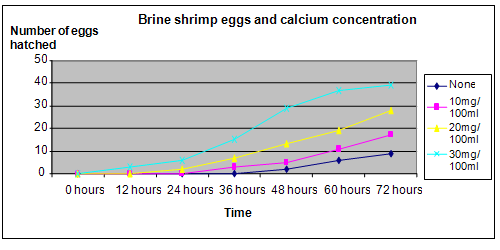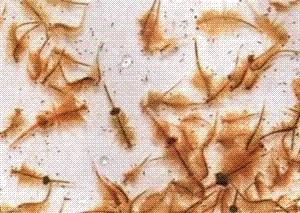| Complexity level: | 8 |
| Project cost ($): | 30 |
| Time required: | 2 hours to prepare, 3 days for the science project experiment |
| Material availability: | Easily found at pet/aquarium store |
| Safety concerns: | None |
Hypothesis
Higher concentrations of calcium in water will make brine shrimp eggs hatch more quickly.
Overview
Brine shrimp
Brine shrimps are aquatic crustaceans known to have existed for over a thousand years. Their eggs are able to remain in a state of total stasis for as long as 2 years, in conditions without oxygen, below freezing temperatures and even above boiling temperatures. In short, they are extremely hardy! They will remain metabolically inactive during this period in a condition known as "cryptobiosis" or “hidden life”.
However, once the eggs are placed in salted water, they will be able to hatch within a few hours. The hatched larvae are called "nauplii" and they measure about 0.5 mm in length. The average life cycle of a brine shrimp is 1 year. During this period, a matured and fully grown shrimp can grow up to 1 centimeter in length.
Brine shrimp found in the wild will normally live on microscopic algae and plankton. The brine shrimp that is grown in cultures or inside aquariums are normally fed with yeast, egg yolk, soybean powder or wheat flour. Brine shrimp are normally able to tolerate different levels of water salinity.
Scientific Terms
Materials
The materials required for this science fair project:
- 1 bottle of brine shrimp eggs
- 1 table spoon
- 4 petri dish
- 1 beaker
- 400ml distilled water
- 25mg salt
- 1 measuring cylinder
- 1 digital weighing scale
- 1 bottle of calcium
- 1 magnifying glass
- 1 black marker pen
Procedure
1. For this science fair project, the independent variable is the concentration of calcium in the water – no calcium (0mg/100ml), 10mg/100ml, 20mg/100ml or 30mg/100ml. The dependent variable is the number of brine shrimp eggs that successfully hatch. This is determined by inspecting the petri dish under the magnifying glass and counting the number of hatched brine shrimp that hatch, every 12 hours. The constants (control variables) are the size of the petri dish, the salinity of the water and the room temperature.
2. The 4 petri dishes are marked A, B, C, D using a black marker pen.
3. 400ml of distilled water and 25mg salt are mixed in the beaker. 100ml of the solution is measured using the measuring cylinder and poured into each of the 4 petri dishes.
4. 10mg of calcium is added to the petri dish marked B. 20mg and 30mg of calcium is added to the petri dishes marked C and D. The calcium powder is mixed into the solution. No calcium power is added to the petri dish labeled A.
5. A half table spoon of brine shrimp eggs is sprinkled carefully over each of the 4 petri dishes.
6. Using the magnifying glass, the contents of the petri dishes are observed every 12 hours. The number of hatched brine shrimp is counted and recorded.

Results
The higher concentration of calcium in the water caused the eggs to hatch more quickly.
|
Calcium concentration |
Calcium concentration and the number of brine shrimp eggs hatched |
||||||
|
0 hours |
12 hours |
24 hours |
36 hours |
48 hours |
60 hours |
72 hours |
|
|
None |
0 |
0 |
0 |
0 |
2 |
6 |
9 |
|
10mg/100ml |
0 |
0 |
0 |
3 |
5 |
11 |
17 |
|
20mg/100ml |
0 |
0 |
2 |
7 |
13 |
19 |
28 |
|
30mg/100ml |
0 |
3 |
6 |
15 |
29 |
37 |
39 |
The graph below represents the result of our science project experiment.

Conclusion
Our hypothesis has been proven to be correct. Higher concentrations of calcium in water will make brine shrimp eggs hatch more quickly.
Newly hatched brine shrimp larvae normally have very good nutritional properties. They are normally sold as fish food in aquarium shops. These young brine shrimp are rich in unsaturated fatty acids and lipids.
The ability of brine shrimp to remain in a dormant state for long periods has generated interest amongst scientists involved in researching technologies for space travel.
Also consider
Try using the eggs of different types of crustaceans, like prawns, crabs or lobsters. A larger sample should be used to improve the reliability of the results of our science experiment.
Try to repeat the science project, this time, observing the effect of adding other nutrients such as vitamin C or iron to the water.
References
Brine shrimp - http://en.wikipedia.org/wiki/Brine_shrimp
DIY hatching brine shrimp - http://saltaquarium.about.com/od/diyfeedersfoods/ss/sbshatchbrinesh.htm

